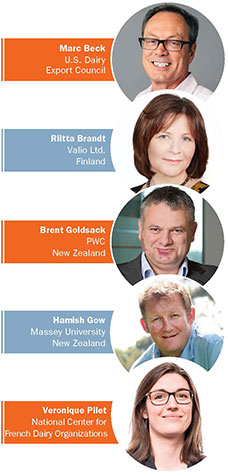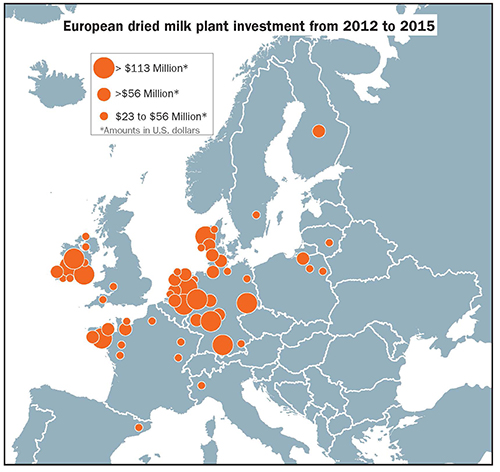
The dairy world is definitely out of kilter," commented New Zealand's Brent Goldsack during a discussion about the international supply and demand of dairy products.
"I would say that we are struggling to recalibrate the industry," concurred U.S. Dairy Export Council's (USDEC) Marc Beck. "At the farm gate, we may not see a milk price recovery until 2017 or 2018. That may happen because it may take that long to clear mounting dairy product inventories" stated the market specialist.






Filling warehouses
As for the near term, U.S. cheese inventories have been building to a generational high. In March 2016, there were 1.9 million pounds of natural cheese in warehouses, based on USDA statistics. The last time inventories peaked at those levels, Ronald Reagan was completing his first term as U.S. President in June 1984. Of those cheese stocks, 61 percent are American cheese varieties such as Cheddar. On the dairy product supply side, Europe’s postquota dairy growth has been higher than most analysts projected. “In no way have we accurately projected Europe’s ability to make milk,” said Beck. “We now project that the EU will grow dairy exports 4 to 6 percent annually through 2020.” To that end, Europe’s milk output has been up 5.2 percent in the first two months of 2016 alone. “Dairy farmers react to lower prices with higher volumes,” noted Veronique Pilet with the National Center for French Dairy Organizations. At this point, Europe too is facing lower pay prices that have approached intervention or support levels. This has partially occurred as the collective European continent searches out new homes for its dairy products after Russian President Vladimir Putin closed the Russian border to dairy products from many Western nations that also support the Ukraine in an ongoing military conflict with his country. That displaced 200,000 tons of cheese in 2013 alone. “When the border closed, it was immediate,” said Riitta Brandt with Valio Ltd., Finland’s leading dairy company that processes 80 percent of the nation’s milk. That impacted Finland significantly as it shares a 833-mile border with Russia. “Prior to the Russian dairy product ban, the country imported 400,000 tons of cheese in 2013,” said Brandt. “That was immediately cut in half to 200,000 tons, which was the same level in Russia as 2004,” said Brandt, who doesn’t see any change in the Russian ban this year or 2017 for that matter.Kiwis hit hard
The Russian ban, low oil prices that have reduced purchasing power, and slowed buying from China have collectively stalled dairy sales. While milk prices have fallen across the globe, New Zealand has been hit the hardest. That’s because the island nation of 4 million people and 5 million dairy cows exports 90-plus percent of its milk and dairy products. “New Zealand usually leads the dairy-price cycle,” said Goldsack, who is a managing partner with New Zealand firm PWC (PricewaterhouseCoopers) and the lead partner for their agricultural practice. “The current New Zealand milk price is $3.90 per kilogram of milk solids and that equates to $10.41 per hundredweight. “Presently, we are losing 50 cents to $1 per kilogram of milk solids,” said Goldsack as he noted New Zealand’s milk payout is down from $8.40 per kilogram of milk solids in the 2013-2014 season. In response, New Zealand dairy farmers have slashed costs and nonessential assets. Goldsack, who also is a farm financial specialist, said that North Island dairy farmers had reduced Farm Working Expenses (FWE) by 21 percent over the past two seasons, while South Island farmers have cut costs by 16 percent. He noted that the South Island portion of the country converted to dairy over the recent boom period has higher operating expenses and more marginal farmland. “U.S. farmers will have to do the same (cut costs) if they are going to survive,” he advised. For the current production season, North Island costs have been running between $11.58 to $12.91 per hundredweight while those numbers climb to $13.40 to $14.75 on the South Island. The financial stress is definitely hitting the home front. “We’ve seen an increase in suicides and domestic violence among our farming households,” said Goldsack in a very sobering tone. “The current economic modeling would indicate that there will be a lot of farms down to 0 percent equity by the 2017-2018 season,” predicted Hamish Gow with New Zealand’s Massey University. “Nearly all the loan covenants have been broken this year and nearly every farm has shifted to interest-only payments. So far, banks are holding together and sticking with the dairy farming community,” said the agricultural economics and rural finance specialist who studied at Cornell and was previously on the faculty at the University of Illinois and Michigan State. Not all that debt is held proportionally, Gow went on to explain. “About 80 percent of the debt is held by 20 percent of the farms.”








